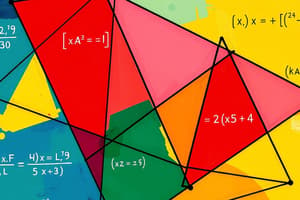Podcast
Questions and Answers
What fundamental concept in geometry is still studied and applied today, with origins dating back to ancient times?
What fundamental concept in geometry is still studied and applied today, with origins dating back to ancient times?
- Addition and subtraction
- Pythagorean theorem (correct)
- Multiplication and division
- Algebraic equations
Which term refers to the branch of mathematics dealing with size, shape, relative position of figures, and properties of space?
Which term refers to the branch of mathematics dealing with size, shape, relative position of figures, and properties of space?
- Algebra
- Geometry (correct)
- Calculus
- Statistics
What type of geometry involves locating points, finding distances, and plotting shapes on a coordinate plane?
What type of geometry involves locating points, finding distances, and plotting shapes on a coordinate plane?
- Transformations
- Coordinate geometry (correct)
- 3D geometry
- Angular geometry
In geometry, which concept involves identifying slides, flips, and turns that change the shape and position of figures?
In geometry, which concept involves identifying slides, flips, and turns that change the shape and position of figures?
What properties of shapes are studied in geometry, including diameter, circumference, area, and perimeter?
What properties of shapes are studied in geometry, including diameter, circumference, area, and perimeter?
What is one key topic covered in the 6th class curriculum as mentioned in the text?
What is one key topic covered in the 6th class curriculum as mentioned in the text?
How does geometry intertwine with other areas of math in the 6th class curriculum?
How does geometry intertwine with other areas of math in the 6th class curriculum?
How does geometry contribute to everyday life, according to the text?
How does geometry contribute to everyday life, according to the text?
What skill does geometry help enhance according to the text?
What skill does geometry help enhance according to the text?
Why is the 6th class curriculum designed to introduce students to a wider range of mathematical concepts?
Why is the 6th class curriculum designed to introduce students to a wider range of mathematical concepts?
Flashcards are hidden until you start studying
Study Notes
Discovering the World of Math: Geometry and 6th Class Curriculum
Mathematics is a vast and interconnected field, offering endless opportunities for exploration and understanding. In this article, we'll delve into two aspects of math education—geometry and the 6th class curriculum—to help you appreciate the beauty and importance of these subjects.
Geometry: Shape, Space, and Measurement
Geometry is the branch of mathematics that deals with size, shape, relative position of figures, and the properties of space. Its origins can be traced back to ancient times, with fundamental concepts like the Pythagorean theorem and Euclid's axioms still being studied and applied today.
In geometry, we learn about:
- Shapes and their properties: Circle, square, rectangle, triangle, polygon, and their characteristics like diameter, circumference, area, and perimeter.
- Angles and their properties: Measuring angles, angle addition, angle subtraction, and understanding special angles (right, acute, obtuse, and straight).
- Coordinate geometry: Locating points, finding their distance, and plotting the position of shapes on a coordinate plane.
- Transformations: Identifying slides, flips, and turns, and understanding how they change the shape and position of figures.
- 3D geometry: Solids, volume, surface area, and coordinate geometry in three dimensions.
Maths 6th Class Full Chapters
In the 6th class curriculum, children acquire a strong foundation in mathematics, building upon their previous knowledge while developing new skills. Some of the key topics covered include:
- Number system: Understanding the properties of integers, decimals, and fractions.
- Algebra: Solving linear equations, quadratic equations, and basic algebraic expressions.
- Geometry: Measurement of angles, lengths, and areas.
- Shapes and their properties: Identifying and classifying polygons, triangles, and prisms.
- Transformations: Understanding slides, flips, and turns.
- Coordinate geometry: Plotting points and finding distances.
- Probability: Understanding probability and its applications.
- Data analysis: Collecting, organizing, and interpreting data.
- Practical life problems: Solving real-life problems using mathematical concepts.
In the 6th class curriculum, geometry is not just a standalone subject; it intertwines with other areas of math, such as algebra and data analysis. This integrated approach helps students to see the connections between different mathematical concepts and develop a deeper understanding of the subject as a whole.
The Importance of Geometry
Geometry serves as the foundation of many other subjects, such as architecture, engineering, and computer science. It's used to study the structure of our universe, to create designs for buildings and products, and to develop algorithms for computing systems.
In everyday life, geometry is also essential, helping us to understand the world around us. It allows us to read maps, measure distances, and build structures. Moreover, geometry enhances problem-solving and critical-thinking skills, making students better equipped to tackle complex challenges in their future careers and personal lives.
The 6th class curriculum is designed to introduce students to a wider range of mathematical concepts, laying the groundwork for more advanced studies in their future education. As students gradually develop their understanding of geometry and its applications, they'll become more adept at solving complex problems and designing innovative solutions. Ultimately, they'll gain a deeper appreciation for the power of math and its endless possibilities.
Studying That Suits You
Use AI to generate personalized quizzes and flashcards to suit your learning preferences.




